Nitric oxide regulates DELLA content and PIF expression to promote photomorphogenesis in Arabidopsis
- PMID: 21562334
- PMCID: PMC3135954
- DOI: 10.1104/pp.111.177741
Nitric oxide regulates DELLA content and PIF expression to promote photomorphogenesis in Arabidopsis
Abstract
The transition from etiolated to green seedlings involves a shift from hypocotyl growth-promoting conditions to growth restraint. These changes occur through a complex light-driven process involving multiple and tightly coordinated hormonal signaling pathways. Nitric oxide (NO) has been lately characterized as a regulator of plant development interacting with hormone signaling. Here, we show that Arabidopsis (Arabidopsis thaliana) NO-deficient mutant hypocotyls are longer than those from wild-type seedlings under red light but not under blue or far-red light. Accordingly, exogenous treatment with the NO donor sodium nitroprusside and mutant plants with increased endogenous NO levels resulted in reduced hypocotyl length. In addition to increased hypocotyl elongation, NO deficiency led to increased anthocyanin levels and reduced PHYB content under red light, all processes governed by phytochrome-interacting factors (PIFs). NO-deficient plants accordingly showed an enhanced expression of PIF3, PIF1, and PIF4. Moreover, exogenous NO increased the levels of the gibberellin (GA)-regulated DELLA proteins and shortened hypocotyls, likely through the negative regulation of the GA Insensitive Dwarf1 (GID1)-Sleepy1 (SLY1) module. Consequently, NO-deficient seedlings displayed up-regulation of SLY1, defective DELLA accumulation, and altered GA sensitivity, thus resulting in defective deetiolation under red light. Accumulation of NO in wild-type seedlings undergoing red light-triggered deetiolation and elevated levels of NO in the GA-deficient ga1-3 mutant in darkness suggest a mutual NO-GA antagonism in controlling photomorphogenesis. PHYB-dependent NO production promotes photomorphogenesis by a GID1-GA-SLY1-mediated mechanism based on the coordinated repression of growth-promoting PIF genes and the increase in the content of DELLA proteins.
Figures
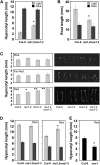
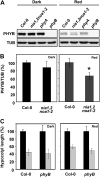
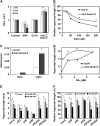
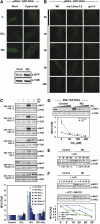
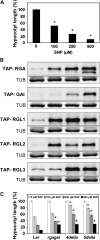
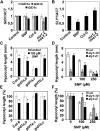
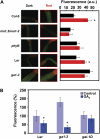

Similar articles
-
Phytochrome signaling in green Arabidopsis seedlings: impact assessment of a mutually negative phyB-PIF feedback loop.Mol Plant. 2012 May;5(3):734-49. doi: 10.1093/mp/sss031. Epub 2012 Apr 5. Mol Plant. 2012. PMID: 22492120 Free PMC article.
-
Blue light-dependent interactions of CRY1 with GID1 and DELLA proteins regulate gibberellin signaling and photomorphogenesis in Arabidopsis.Plant Cell. 2021 Aug 13;33(7):2375-2394. doi: 10.1093/plcell/koab124. Plant Cell. 2021. PMID: 34046684 Free PMC article.
-
Coordinated regulation of Arabidopsis thaliana development by light and gibberellins.Nature. 2008 Jan 24;451(7177):475-9. doi: 10.1038/nature06448. Nature. 2008. PMID: 18216856 Free PMC article.
-
Molecular basis and evolutionary pattern of GA-GID1-DELLA regulatory module.Mol Genet Genomics. 2014 Feb;289(1):1-9. doi: 10.1007/s00438-013-0797-x. Epub 2013 Dec 10. Mol Genet Genomics. 2014. PMID: 24322346 Review.
-
The angiosperm gibberellin-GID1-DELLA growth regulatory mechanism: how an "inhibitor of an inhibitor" enables flexible response to fluctuating environments.Plant Cell. 2009 May;21(5):1328-39. doi: 10.1105/tpc.109.066969. Epub 2009 May 26. Plant Cell. 2009. PMID: 19470587 Free PMC article. Review.
Cited by
-
Sugars, the clock and transition to flowering.Front Plant Sci. 2013 Feb 14;4:22. doi: 10.3389/fpls.2013.00022. eCollection 2013. Front Plant Sci. 2013. PMID: 23420760 Free PMC article.
-
PLC1 mediated Cycloastragenol-induced stomatal movement by regulating the production of NO in Arabidopsis thaliana.BMC Plant Biol. 2023 Nov 17;23(1):571. doi: 10.1186/s12870-023-04555-7. BMC Plant Biol. 2023. PMID: 37978426 Free PMC article.
-
Switch from heterotrophy to autotrophy of apple cotyledons depends on NO signal.Planta. 2015 Nov;242(5):1221-36. doi: 10.1007/s00425-015-2361-x. Epub 2015 Jul 18. Planta. 2015. PMID: 26186967 Free PMC article.
-
Nitric oxide molecular targets: reprogramming plant development upon stress.J Exp Bot. 2019 Aug 29;70(17):4441-4460. doi: 10.1093/jxb/erz339. J Exp Bot. 2019. PMID: 31327004 Free PMC article. Review.
-
Nitric Oxide Enables Germination by a Four-Pronged Attack on ABA-Induced Seed Dormancy.Front Plant Sci. 2018 Mar 9;9:296. doi: 10.3389/fpls.2018.00296. eCollection 2018. Front Plant Sci. 2018. PMID: 29593760 Free PMC article.
References
-
- Achard P, Cheng H, De Grauwe L, Decat J, Schoutteten H, Moritz T, Van Der Straeten D, Peng J, Harberd NP. (2006) Integration of plant responses to environmentally activated phytohormonal signals. Science 311: 91–94 - PubMed
-
- Achard P, Genschik P. (2009) Releasing the brakes of plant growth: how GAs shut down DELLA proteins. J Exp Bot 60: 1085–1092 - PubMed
-
- Achard P, Renou J-P, Berthomé R, Harberd NP, Genschik P. (2008) Plant DELLAs restrain growth and promote survival of adversity by reducing the levels of reactive oxygen species. Curr Biol 18: 656–660 - PubMed
-
- Agrawal L, Chakraborty S, Jaiswal DK, Gupta S, Datta A, Chakraborty N. (2008) Comparative proteomics of tuber induction, development and maturation reveal the complexity of tuberization process in potato (Solanum tuberosum L.). J Proteome Res 7: 3803–3817 - PubMed
Publication types
MeSH terms
Substances
LinkOut - more resources
Full Text Sources
Molecular Biology Databases

